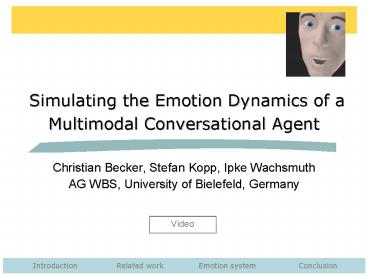Christian Becker, Stefan Kopp, Ipke Wachsmuth - PowerPoint PPT Presentation
1 / 12
Title:
Christian Becker, Stefan Kopp, Ipke Wachsmuth
Description:
... significant positive or negative valence present boredom value increases linearly ... Valence of mood and degree of boredom. Corresponding PAD triple ... – PowerPoint PPT presentation
Number of Views:54
Avg rating:3.0/5.0
Title: Christian Becker, Stefan Kopp, Ipke Wachsmuth
1
Simulating the Emotion Dynamics of a Multimodal
Conversational Agent
- Christian Becker, Stefan Kopp, Ipke Wachsmuth
- AG WBS, University of Bielefeld, Germany
Video
2
The agent Max
Kinematic skeleton with 53 degrees of freedom
- Body animated by model-based animation
- Cognitive architecture based on a BDI framework
- Text-to-speech system (German only)
- TXT2PHO (IKP Uni Bonn) and MBROLA
- Phoneme transcription as basis for automatic
generation of visemes - Facial animation based on 21 simulated muscles
- Coordinated control of face muscles based on
Action Units (Ekman/Friesen) - Six muscle sets defined for emotional expressions
surprised
angry
sad
bored
fearful
happy
Introduction
3
Two interaction scenarios
An embodied conversational agent situated in
virtual reality
- (1) Multimodal Assembly eXpert
- SFB 360 research scenario
- Located in a 3side cave-like projection
- User input via speech and gestures
- Action selection influenced by the concurrent
emotion system
- (2) Presentation agent in the HNF museum
- Multimodal presentation module extended by
eliza-like, smalltalk abilities - User interaction via keyboard
- User perception via video camera
- Proactive behaviors triggered by the concurrent
emotion system
Introduction
4
Why not OCC?
Ortony, Clore and Collins (1988) An appraisal
theory of emotions
- Positive aspects of the OCC model
- covers most situations an emotional agent might
have to deal with - offers a structure to determine the intensity of
emotion types - Untackled questions within the OCC model
- the OCC model contains no history
- the interactions of different emotion categories
are not described - the course of emotions over time is not
considered - and last but not least
The non-cognitive emergence of emotions is
neglected by this model! (E.g. The experience
of relaxation when sitting in front of a warm
oven.)
Related work
5
The emotion system an overview
Simulating the dynamics of emotional impulses
- Dynamic component Conceptual linkage of emotions
and moods - CategorizationMapping onto weighted emotion
categories in PAD space by using a distance metric
Input
Output
- Valence of emotions short-time system state
- Valence of moods longer lasting system state
- (P)leasure ranges from joy (P) to reluctance
(-P) - (A)rousal ranges from mental awareness (A) to
sleepiness (-A) - (D)ominance describes the agents feelings of
control over the situation
Emotion system
6
1. Dynamic component
- Simulating the alleviating and fortifying effects
of emotions (x) on moods (y) (as indicated by the
vertical arrows) - Physical simulation of two spiral springs with
spring constants dx and dy
Provides triple (x, y, z) at every timestep t
with 25Hz!
Emotion system
7
Mapping to PAD space
Emotion (x), mood (y) and boredom (z) are mapped
to (p)leasure and (a)rousal according to the
following equations
d
p
y
z
x
a
The dominance value is not deducible from the
dynamic component!
Emotion system
8
2) Categorization (PAD) component
- Nine emotion categories represented by their PAD
triples - ( p , a , d )
- angry (-0.8, 0.8, 1.0)
- annoyed (-0.5, 0.0, 1.0)
- bored ( 0.0, -0.8, 1.0)
- concentrated ( 0.0, 0.0, /- 1.0)
- depressed ( 0.0, -0.8, -1.0)
- fearfull (-0.8, 0.8, -1.0)
- friendly ( 0.5, 0.0, /- 1.0)
- sad (-0.5, 0.0, 1.0)
- surprised ( 0.8, 0.8, /- 1.0)
- Two thresholds are defined
- Activation threshold ?.
- Saturation threshold ?.
d
Emotion system
9
Visualisation of the emotional state
- Output of the emotion system
- Valence of mood and degree of boredom
- Corresponding PAD triple
- Activated emotion category with weight w or state
of confusion otherwise - 1) Non-cognitive effects
- Weighted facial expressions according to the
actual emotion category - Modulation of breath and eye-blink frequency by
arousal value - Modulation of pitch and rate of speech according
to the emotion category - Triggering of secondary actions by boredom value
- Cognitive effects
- Emotion categories incessantly asserted as belief
of the agent - Agents plan selection influenced by current
emotion category
Emotion system
10
Example
- HNF scenario since January 2004
- Emotion system provided with emotional impulses
by perception, interpretation and dialog manager - It influences dialog manager (cognitive) and
behavior generation (non-cognitive)
emotionsystem
behaviorplanning
dialogmanager
inter-pretation
behavior generation
perception
Video
Conclusion
11
Conclusion
- Combination of moods, emotions and boredom to
achieve a coherent long-time behavior as well as
convincing spontaneous reactions - Involuntary facets of Maxs behavior, his facial
expressions and his deliberation process are
continuously modulated by the emotion system - Higher-level emotion categories not representable
- Open questionHow can the dominance value be
specified automatically?
Conclusion
12
Thank you for your attention!































